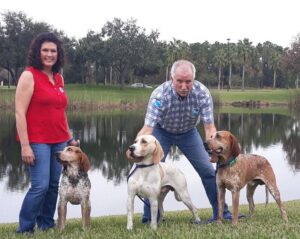
River Bottom American English Coonhounds | Franklin Williams & Tracy Kaecker
Franklin Williams and Tracy Kaecker are the breeders behind River Bottom American English Coonhounds. Learn about the kennel.
Home » Dog Breeds » American English Coonhound
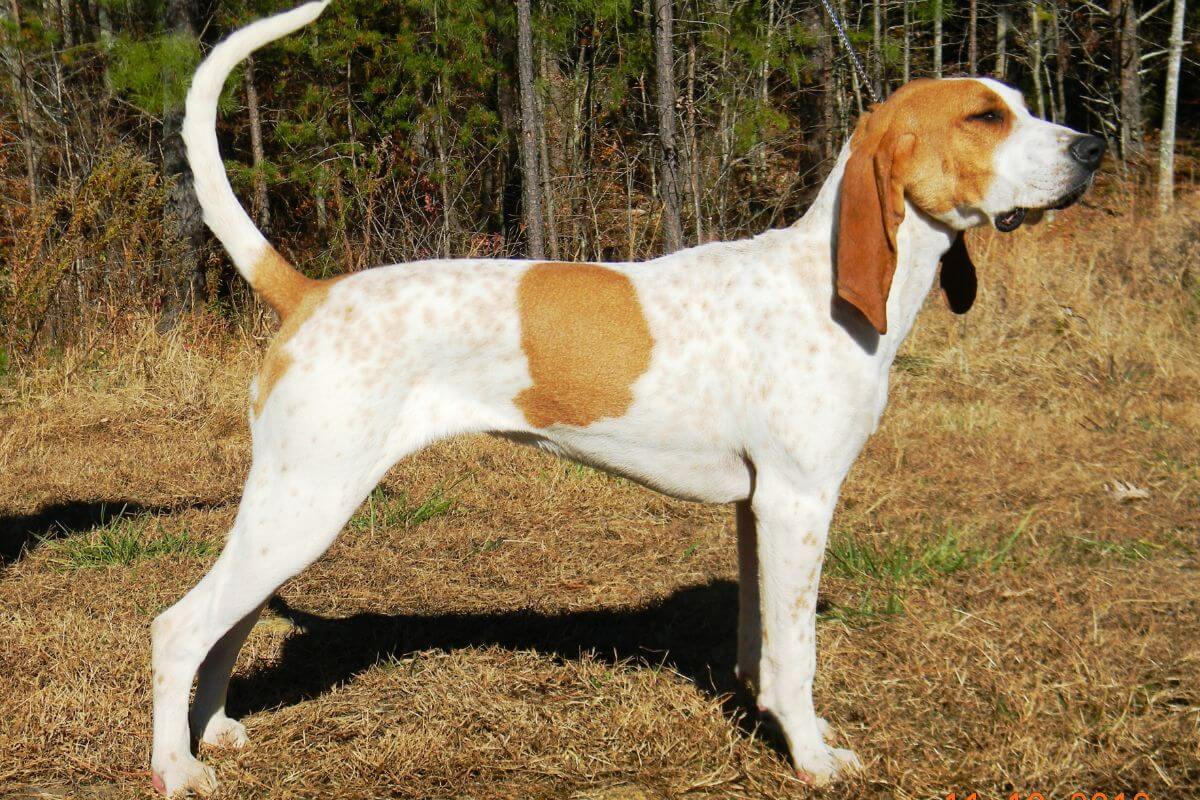
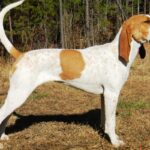
The American English Coonhound, sometimes called the Redtick Coonhound, is a striking embodiment of athleticism, grace, and stamina. Originally bred for hunting raccoons and foxes, this hard-driving hunting breed is recognized for its speed and endurance, making it a favorite among hunters and dog sports enthusiasts alike.
Hound
23 – 26 Inches
45 – 65 Pounds
11 – 12 Years
| Country of Origin | United States |
|---|---|
| Bred For | Hunting, Tracking |
| Known For | Speed, Endurance, Loud Voice |
| Popularity | Low |
| Temperament | Pleasant, Alert, Confident |
| Activities | Hunting, Tracking, Running, Conformation Shows, Dog Sports |
The American English Coonhound boasts a history that is intertwined with early American settlement. Originally, the breed was developed from the descendants of English Foxhounds that were brought to the United States in the 17th century. Settlers, including notable figures such as President George Washington, valued these hounds for their hunting prowess, particularly in pursuing foxes during the day and trailing raccoons at night.
As settlers moved westward and southward, they required hounds that could navigate the challenging terrain of the dense forests and rough landscapes of the Appalachian Mountains. English Foxhounds were then bred with other breeds to produce a hound that was faster and had a more acute sense of smell. This new breed, adept at treeing game, became a favorite among raccoon hunters, leading to its moniker, the “coonhound.”
Over time, regional coonhound varieties were developed. The United Kennel Club (UKC) first recognized the American English Coonhound in 1905 as the English Fox and Coonhound. However, distinctions within the breed led to the Treeing Walker Coonhound gaining separate UKC recognition in 1945, severing its association with the English Fox and Coonhound. The subsequent year saw the Bluetick Coonhound also establish itself as a distinct breed.
The evolution of the breed continued into the latter half of the 20th century. The American English Coonhound entered the American Kennel Club’s (AKC) Foundation Stock Service in 1995. A significant milestone came in 2010 when it progressed to AKC’s Miscellaneous Class. The breed’s formal AKC recognition in the Hound Group in 2011 marked it as the 171st breed to be fully recognized by the registry. This paved the way for the American English Coonhound to participate in prominent dog shows as well as in coonhound events. Starting in 2011, the breed became eligible to compete in the National Dog Show, and by 2012, it could partake in such esteemed events as the Westminster Kennel Club Dog Show and the AKC National Championship.
Today, the American English Coonhound stands as a testament to the legacy of American dog breeding and is a blend of endurance, agility, and charm that reflects the breed’s multifaceted heritage.
Adult male American English Coonhounds typically stand between 24 and 26 inches at the shoulder, while mature females usually range from 23 to 25 inches tall.
In terms of weight, American English Coonhounds generally weigh between 45 and 65 pounds.
The American English Coonhound has a well-proportioned physique that allows for efficient movement. The body is slightly longer than the dog is tall, providing this hound with a balanced gait that is essential for chasing prey over great distances. This hound’s build is moderately racy but well-muscled, ensuring it possesses both the strength and agility that’s needed to get the job done.
Texture: The American English Coonhound’s coat is of medium length, smooth to the touch, and hard enough to provide protection against the rough terrain that is typically encountered during hunting escapades. The characteristic coat ensures the hound remains unburdened while pursuing game and yet shielded from potential scrapes and minor injuries.
| Standard Color | |
|---|---|
| Black & Tan | ee |
| Black | ee |
| Blue | ee |
| Brown | ee |
| Red | ee |
| Tri-Colored | ee |
| White & Tan | ee |
| Red & White | ee |
Markings: Ticked
A Note About Color: Solid-colored dogs with less than ten percent ticking, and tri-colored dogs with no ticking, are unacceptable in this coonhound. Likewise, any brindle color is unacceptable in the breed.
The tail of the American English Coonhound is a significant feature that complements the breed’s overall athletic silhouette. It’s an extension of the spine and acts as a rudder, aiding balance, especially during high-speed chases or when making sharp turns.
The tail is set high, extending in a gentle curve and gradually tapering towards the tip. In terms of length, it reaches the hocks when the dog is in a relaxed stance.
The breed’s tail is left undocked, with a characteristic “brush” of hair that is especially visible towards the tip. The tail is often seen wagging, especially when the dog is excited or on the scent trail.
Choosing to own an American English Coonhound is an invitation to experience a partnership with a breed that is both historically significant and filled with vigor each and every day. The breed’s lineage as a hunter brings with it certain characteristics that potential owners should be aware of, ensuring both the hound and its handler have a fulfilling experience together.
The overall health of the American English Coonhound is robust, thanks to its active heritage and selective breeding. A strong physique not only makes these hounds agile hunters, it also grants them a resilience against ailments that might affect other breeds.
Lifespan: On average, the American English Coonhound can be expected to live between 11 and 12 years.
While the American English Coonhound is a generally healthy breed, as with all breeds and mixed breeds, they can be susceptible to certain health conditions. Awareness and early detection are key to maintaining the hound’s well-being.
Regular check-ups with a veterinarian, especially as the dog ages, can aid in early detection of these health issues. Along with the owner’s observant eye for any change in behavior or appearance, vet visits will allow the American English Coonhound to receive timely care and intervention when needed.
The American English Coonhound is a bundle of enthusiasm that’s deeply rooted in its hunting ancestry. Potential owners should appreciate the nuances of this breed’s character to forge a memorable and lasting relationship with these hunting hounds.
The breed’s dynamic nature might sometimes appear overwhelming, especially for novice or first-time dog owners. Consistent leadership helps them channel their vigor in constructive directions. Their innate sensitivity means these dogs respond most positively to gentle training methods that revolve around positive reinforcement. A stern reprimand can deeply affect them, making patience an essential trait in their human companions.
Left alone, these coonhounds can exhibit signs of anxiety or even delve into destructive behaviors. Their preference is for companionship, reflecting their cooperative hunting nature. This sociable nature extends to their interactions with other dogs. Historically, working in packs, they often enjoy the company of other canines and can integrate well if introduced and socialized from a young age.
Families with young children will find a friend in the American English Coonhound. The breed’s inherent kindness makes these dogs suitable playmates, though their lively nature suggests that playtimes should be supervised for everyone’s safety. Their background, which requires collaboration and coordination, generally renders them dog-friendly, but early introductions to unfamiliar dogs can be beneficial to smooth interactions.
When it comes to strangers, the American English Coonhound is typically friendly and inviting. Still, the breed’s vigilant side might prompt these dogs to sound a vocal alert upon detecting an unfamiliar presence, not as a sign of aggression but as a “heads-up” for their family.
Feeding the American English Coonhound requires attention to the breed’s specific needs, driven by the dog’s active nature and robust constitution. When considering the nutritional requirements of this breed, it’s essential to account for age, activity level, and any unique health concerns.
For puppies, their early growth phase means they need a diet rich in essential nutrients to support bone and muscle development. Puppy-specific formulas, often denser in certain nutrients and calories, can be an excellent choice. Introducing puppies to a regular feeding routine early on helps to establish healthy eating habits and prevents overeating.
As the coonhound transitions to adulthood, their dietary needs shift. An adult American English Coonhound, particularly one that is active or involved in sporting activities, may require a diet that supports sustained energy release. Typically, this means a high-quality commercial dog food that lists meat as the primary ingredient, supplemented by wholesome grains, vegetables, and essential fats.
In terms of quantity, the average American English Coonhound might consume anywhere between 2 to 2.5 cups of dry dog food daily. However, it’s vital to monitor the dog’s weight and adjust portions based on activity levels. Overfeeding can lead to obesity, a condition that can strain the joints and shorten any dog’s lifespan.
While some owners might be tempted to offer multiple meals throughout the day, a structured feeding routine involving one or two fixed meal times can be more beneficial. It not only establishes predictability but also aids in digestion.
Remember, fresh water should always be available. And while treats can be a valuable training tool, they should be offered in moderation to prevent excessive calorie intake.
Training an American English Coonhound brings with it unique challenges and rewards, intricately tied to the breed’s hunting heritage. As a coonhound developed to work closely with humans, they possess an innate intelligence that, when coupled with the dog’s energy, requires a careful approach to training.
Starting early with training is beneficial for the American English Coonhound. Puppyhood offers a malleable period where establishing foundational commands and behaviors can be smoother. As puppies grow, their natural curiosity and determination can sometimes be mistaken for stubbornness. It’s essential to recognize this trait and channel it positively rather than confront it head-on.
Their sensitivity, as highlighted earlier, means that they respond best to positive reinforcement techniques. Reward-based training, involving treats or praise, usually yields the best results. Conversely, negative or punitive measures can be counterproductive, potentially leading to a withdrawn or anxious dog.
Barking can sometimes be a point of contention. Given the breed’s role in tracking and treeing game, the vocalizations of these coonhounds served a purpose. In a modern household setting, this can translate to barking at perceived threats or when they pick up intriguing scents. Training these hounds to control this instinct requires patience and consistency, introducing commands like “quiet” or “enough” and reinforcing them over time.
The breed’s intelligence is evident in its ability to pick up commands quickly. However, these dogs do have a strong prey drive, inherited from their hunting origins. This “wanderlust” or desire to chase can be managed with a combination of training and exercise. Off-leash areas might not be ideal until reliable recall is established.
Lastly, the American English Coonhound’s interaction with other animals can be influenced by the breed’s prey drive. While they are generally good with other dogs, smaller animals might be seen as prey. Early socialization and exposure to various animals can mitigate this instinct, teaching discernment to these active and athletic hounds.
The American English Coonhound’s athletic build and high energy levels are testaments to the breed’s hunting roots, demanding regular and consistent exercise to keep these hounds mentally and physically stimulated.
| Energy Level | Medium-High |
|---|---|
| Exercise Requirements | 1 Hour/Day (Minimum), Daily Walks, Vigorous Running, Regular Exercise, Playing with Other Dogs, Mental Stimulation |
This breed is not one to be content with just a leisurely stroll around the block. The stamina and endurance of these hounds, honed over generations of tracking and treeing game, necessitate more robust activities. A long, brisk walk or even a jog can be an ideal way to channel their energy, helping to keep them fit while also curbing potential behavioral issues that might arise from pent-up energy.
Their playful nature also means these coonhounds enjoy games and interactive activities with their owners. Fetch, tug-of-war, or even hide and seek can be enjoyable, allowing them to engage both their bodies and their keen minds.
Given their high prey drive, it’s essential to be cautious when considering off-leash play in open areas. Until an American English Coonhound has been thoroughly trained to recall reliably, there’s always the risk of the hound catching a scent and following it, oblivious to potential dangers or their owner’s calls.
In terms of intensity, while they do have bursts of high energy, especially when young, these hounds also value their downtime. After a good play session or a long walk, it’s not uncommon for the American English Coonhound to seek a comfortable spot for a nap.
For families with enclosed gardens or yards, these spaces can be ideal for the Coonhound to expend some energy. However, it is important to remember that a secure gate is a must. The breed’s propensity to follow a scent means these dogs might attempt to wander off if they catch a whiff of something intriguing.
Grooming the American English Coonhound, while not excessively demanding, plays a pivotal role in maintaining the dog’s health and ensuring its coat remains lustrous and healthy.
| Coat Type | Hard, Protective Hair, Medium Length |
|---|---|
| Grooming Requirements | Weekly Brushing, Monthly Bathing, Routine Ear Cleaning, Periodic Nail Trimming, Regular Tooth Brushing |
The breed’s relatively short coat is easy to care for, but its density means that routine brushing can be beneficial. A weekly once-over with a medium-bristle brush or a hound glove will help to remove loose hair, distribute natural oils, and give the coat that characteristic sheen. This regular brushing also offers an opportunity to check for any signs of skin issues, pests, or irregularities that might require attention.
Despite its short coat, the American English Coonhound is not entirely immune to shedding. During certain times of the year, especially seasonal transitions, these dogs can shed more profusely. During these periods, increasing the frequency of brushing can help to manage the loose hair and reduce the amount that ends up all over the house.
Bathing should be on an as-needed basis. Given the breed’s penchant for outdoor activities, American English Coonhounds might get into messy situations now and then. However, overbathing can strip their coat of essential oils, leading to dryness or irritation. Using a mild dog-specific shampoo can help to maintain the health and vitality of the skin and coat.
Beyond coat care, other grooming essentials include regular nail trimming, which prevents overgrowth and the complications that can come with it. This hound’s ears, with their characteristic droop, can be prone to moisture buildup and potential infections. Weekly ear checks, coupled with gentle cleaning using a vet-approved solution, can prevent such issues.
Oral health is another aspect not to be overlooked. Regular tooth brushing, coupled with vet-recommended dental chews or toys, can help to reduce tartar buildup and promote overall dental health.
When one considers bringing an American English Coonhound into the home, it is essential to understand the breed’s unique characteristics and needs. These hounds are brimming with energy, enthusiasm, and a signature bay that many find endearing. Their passion as hunters, and their high energy levels, translate into a need for an environment where they have ample exercise and the freedom to explore.
An apartment setting might not be the ideal environment for an American English Coonhound. The breed’s need for space to move and play, combined with its vocal tendencies, can make confined living challenging. These dogs may become restless without regular exercise and mental stimulation, and their baying might not be appreciated by close neighbors.
The coat of the American English Coonhound is of short to medium length, offering limited insulation against colder temperatures. While brief exposure to cold weather is manageable, ensuring they have proper shelter and warmth during the colder months is essential to prevent potential health issues. On the flip side, these hounds tolerate heat reasonably well. However, to prevent heat-related ailments, it’s crucial to be sure they have access to fresh water and a shaded area, and to avoid overexerting them during the hottest parts of the day.
The experience of raising an American English Coonhound puppy is a journey of joy, challenges, and rewarding milestones. From their adorable antics to their boundless energy, these puppies are a blend of affection and mischief. However, as with any dog, the early days are crucial for setting the foundation for a well-adjusted adult companion.
When an American English Coonhound puppy arrives home, it’s essential to focus on the little one’s health, socialization, and training. The pup’s curious nature and keen sense of smell can sometimes lead it into mischief. Puppy-proofing the home by removing potential hazards and providing a safe environment is crucial.
Nutrition is a vital aspect of puppy care. Feeding a balanced diet specifically formulated for puppies ensures they receive the nutrients necessary for growth. Regular check-ups with a veterinarian will allow them to get on the right track health-wise and receive timely vaccinations.
Socialization during the puppy phase is of paramount importance. Exposing the young coonhound to various sounds, sights, and experiences will help to shape its temperament and reduce fear or aggression as it matures. Introducing puppies to different people, animals, and environments will provide many positive experiences.
Training should start early, focusing on basic commands and manners. Due to the breed’s hunting background, American English Coonhounds have a strong prey drive. Training them to recall and obey commands is crucial, especially when outdoors. Consistency, positive reinforcement, and patience are the keys to successful training.
Lastly, love and affection cannot be overstated. These puppies thrive on human interaction and being part of family activities. The bond formed during these early days will lay the groundwork for a lifelong relationship of trust and companionship.
The American English Coonhound’s vibrant energy, agility, and enthusiasm stem from its roots as a hunting and tracking dog. These intrinsic attributes prime these hounds for a range of activities and dog sports:
Engaging an American English Coonhound in these activities satisfies the dog’s physical needs while catering to its innate behaviors, fostering a more content and well-rounded hound.
The American English Coonhound is recognized by the world’s leading registries and kennel organizations, which categorize the breed into a specific Group based on its unique characteristics. This breed is recognized worldwide under the following Group designations:
| Organization | Group Designation |
|---|---|
| AKC (American Kennel Club) | Hound |
| UKC (United Kennel Club) | Scenthound |
| CKC (Canadian Kennel Club) | Not Recognized |
| ANKC (Australian National Kennel Council) | Not Recognized |
| RKC (The Royal Kennel Club) | Not Recognized |
| FCI (Fédération Cynologique Internationale) | Not Recognized |
The ideal American English Coonhound is described by a Breed Standard that is approved by each of the world’s leading registries and kennel organizations. The Breed Standards for this breed may be found in the following links:
| Organization | Breed Standard |
|---|---|
| American Kennel Club | AKC American English Coonhound Breed Standard |
| United Kennel Club | UKC American English Coonhound Breed Standard |
| Canadian Kennel Club | Not Recognized |
| Australian National Kennel Council | Not Recognized |
| The Royal Kennel Club | Not Recognized |
| Fédération Cynologique Internationale | Not Recognized |
The American English Coonhound, given its rich heritage and status as a beloved hunting and companion dog, has garnered the attention of many enthusiasts and professionals. A breed club exists that is dedicated to the promotion, protection, and betterment of the American English Coonhound.
In the United States, the primary club devoted to this breed is the American English Coonhound Association. The club is instrumental in upholding the Breed Standard, facilitating events, and providing resources for breeders and owners alike.
For those interested in delving deeper into the American English Coonhound community or seeking breed-specific guidance, the American English Coonhound Association serves as an invaluable resource. It connects enthusiasts and novices alike, uniting them in their shared passion for this remarkable breed.
While the American English Coonhound is a cherished breed, there are moments when these dogs might find themselves in need of assistance. In such instances, local shelters and dog rescue groups come to their aid. Adopting from these organizations provides a second chance for the coonhound and also supports the commendable work of the group’s volunteers.
Local shelters and rescue groups ensure the well-being of every dog, offering necessary care and preparing them for life in a new home. Those considering adoption can inquire about available coonhounds or even request to be notified should one arrive.
For individuals looking to assist in other ways, many shelters and rescue organizations welcome donations, volunteers, and foster home offers. Every contribution, big or small, can make a significant difference in a dog’s life.
American English Coonhounds are typically friendly and sociable. With their gentle nature and tolerance, they often get along well with children. However, it’s always essential to supervise interactions between dogs and young children to ensure both the child’s and the dog’s safety.
While American English Coonhounds are excellent at “treeing” prey, meaning they can corner them up a tree, they themselves do not climb trees. Instead, their strong bark is used to alert hunters when the prey is treed. It’s their exceptional tracking abilities (and not their climbing skills) that make these dogs standout hunters.
Yes, American English Coonhounds shed, though their shedding is considered moderate. Regular brushing can help to manage the shedding and keep the hound’s short coat looking its best. Like all dogs, they will have increased shedding during seasonal changes.
American English Coonhounds are swift runners, given their hunting background. They can reach speeds comparable to other coonhound breeds, often ranging between 20-25 mph. Their speed, combined with their stamina, makes them effective hunters.
The American English Coonhound’s height varies between males and females. Males typically stand between 24 to 26 inches at the shoulder, while females are slightly smaller, measuring 23 to 25 inches. The breed’s size complements the agile and sturdy physique.
The American English Coonhound descends primarily from the English Foxhound. Other related breeds include the Bluetick Coonhound and the Treeing Walker Coonhound, both of which share some lineage and were historically categorized together with the American English Coonhound as English Fox and Coonhounds.
Like many medium to large-sized breeds, American English Coonhounds typically reach their full adult size by 18 to 24 months of age. It’s essential to provide these dogs with appropriate nutrition during their growing phase to ensure healthy development.
American English Coonhounds possess a protective instinct, a trait ingrained from their early days as hunters and watchdogs. When they perceive a potential threat, especially in their home environment, they may act territorially to safeguard their family. Proper socialization and training from an early age can help to mitigate this behavior.

Franklin Williams and Tracy Kaecker are the breeders behind River Bottom American English Coonhounds. Learn about the kennel.
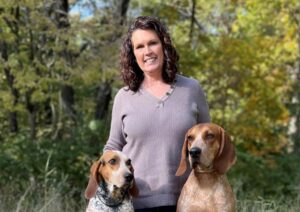
Insights from an Owner Handler, Tracy Kaecker. Tracy shares her opinions on various topics about dog handling in the modern show ring.
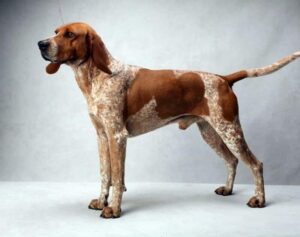
Learn what separates the American English Coonhound from the other Coonhound dog breeds. Comparison by long-time AEC breeder Tracy Kaecker
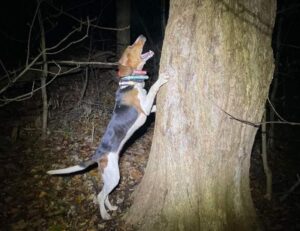
Read and learn about the various coonhound performance events, such as Nite Hunts, Bench Shows, Field Trials, and Water Races.
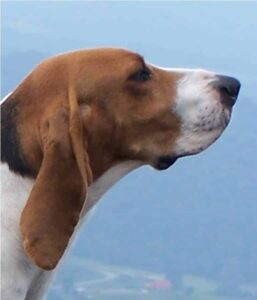
Now that coonhounds are in AKC conformation shows, it is becoming increasingly important that we focus on the correct coonhound structure

Dan Sayers is the Editor-in-Chief of SHOWSIGHT digital and print publications. He received a B.S. from Drexel University where he studied interior architectural design. His professional career has allowed him to develop his planning, problem-solving, and project management skills, which were employed in the office, educational, and financial sectors. While working as a project manager, he earned a Graphic Design Certificate from the University of the Arts and began creating ads for many of America’s top-winning show dogs. Through this work, Dan became Editor-in-Chief of the nation’s first online-only dog show publication. His current role expands on this experience and broadly extends to cover the sport of dogs in Companion and Performance events as well as all aspects of Conformation.
Dan is a long-time member of the Irish Water Spaniel Club of America and is the organization’s current AKC Delegate and Archivist/Historian, as well as a club-approved Breed Mentor. From 2000-2010, he was the club’s AKC Gazette Columnist. He breeds Irish Water Spaniels under the Quiet Storm prefix and has judged the IWSCA National Specialty Sweepstakes twice. Dan is a member of the Morris and Essex Kennel Club as well as the Dog Writers Association of America, which recognized his illustrations in the award-winning canine compendium, the Encyclopedia of K-9 Terminology.
"*" indicates required fields
Showsight Magazine–the world’s most influential purebred dog publication since 1992. Each issue reaches a global audience dedicated to preserving the history and health of purpose bred dogs. Filled with award-winning editorial focused on news and insights from the dog show community, top breeders, handlers, AKC Judges, and more!